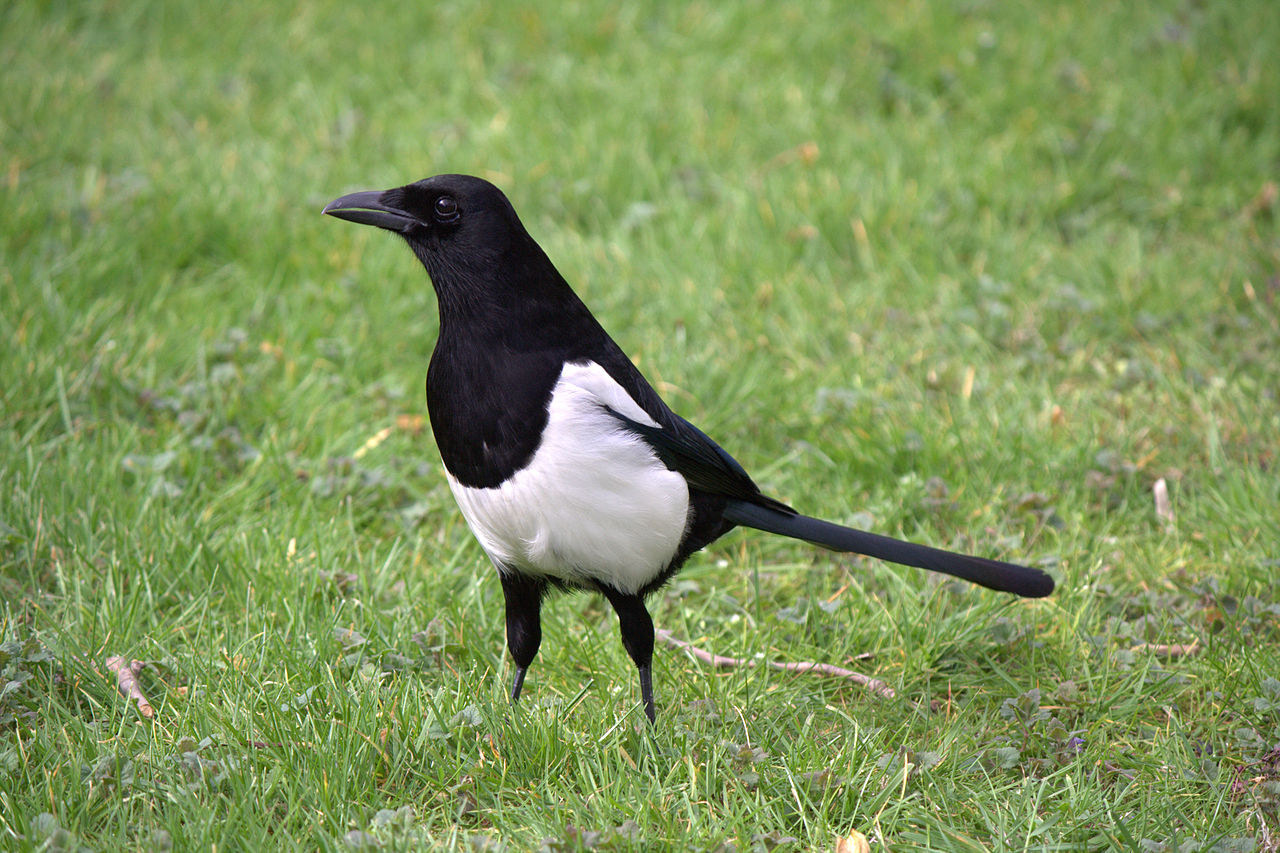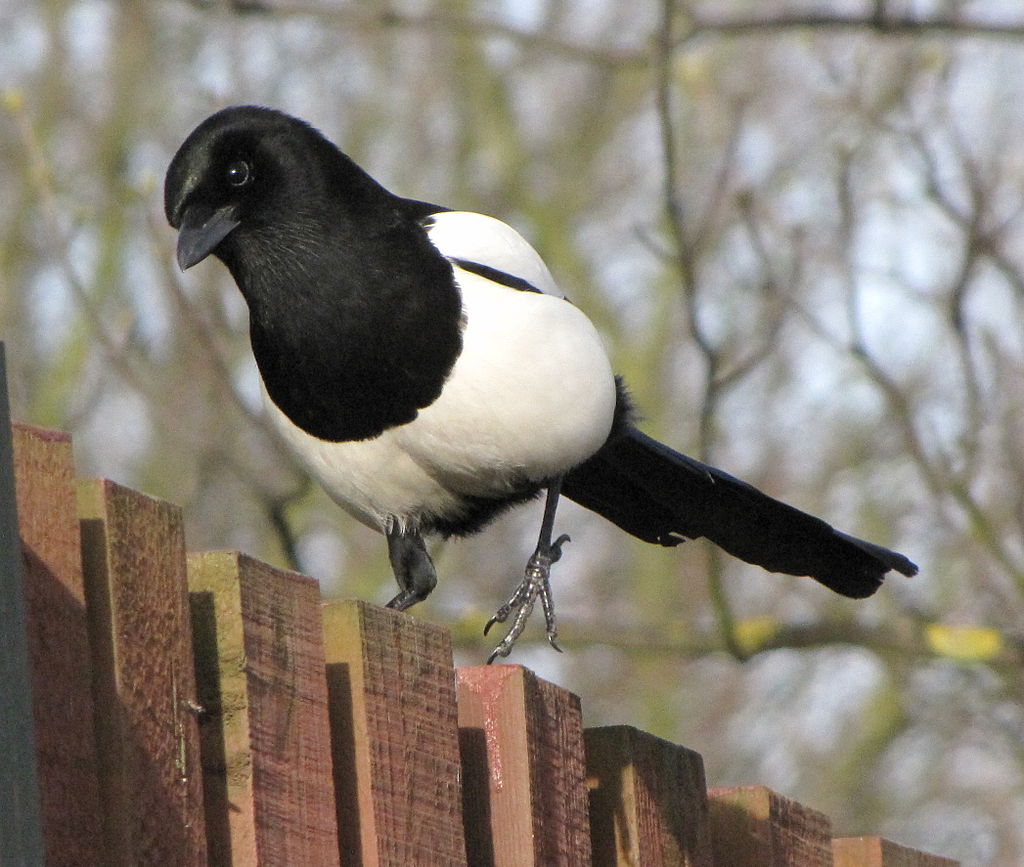Garden Wildlife
Garden Wildlife


What do they eat?
Magpies are typical crows in that they will eat almost anything, invertebrates fruit and scraps. They like road-kill and other carrion – if you are driving in the UK early in the morning you will often see magpies tugging at the remains of mammals killed during the night. They will raid the nests of other birds and take fledglings regularly. I have seen a magpie kill a healthy full-grown starling in my garden. They are also regular visitors to food put out in gardens.
What do they do?
Magpies are usually busy and alert birds, flying about their neighbourhood keeping an eye out for food opportunities, predators, and other magpies. They interact aggressively with their neighbours during the breeding season but in winter they are more gregarious, often forming flocks which roost together – I have seen around 40 in one tree and larger roosts are not uncommon. In late winter and early spring they seem to gather during the day in groups of about a dozen. These are referred to in folklore as ‘weddings’, ‘parliaments’ and so on. It’s assumed they are about setting up territorial boundaries and maybe dominance relations. Because magpies are so prominent, they have a lot of other associated folklore and rhymes. They have a reputation as thieves because they seem to be attracted to bright shiny objects. Stefan Buczacki in his book ‘Fauna Britannica’ summarises some of the folklore and gives hints of the rich literature around magpies.
How are they doing?
The magpie population is currently pretty stable in Britain and Ireland and they are only absent in northern Scotland. In the 19th and early 20th centuries they were ruthlessly persecuted by gamekeepers. This ceased after 1950, and populations increased threefold by 1990, probably helped by the ready availability of roadkill with increased traffic. With an estimated 610,000 territories in Britain, they are abundant in both farmland and built-up areas, and the ninth most commonly recorded species in gardens.
Magpies and songbirds?
There is no doubt that magpies do take eggs and nestlings of songbirds, especially the blackbird. People have assumed that the postwar increase in magpie numbers has been the cause of perceived declines in songbirds. There is little evidence that they cause significant population reductions in gardens, although the impact may be greater in open farmland.
The RSPB states:
"The (BTO) study found that songbird numbers were no different in places where there were many magpies from where there are few. It found no evidence that increased numbers of magpies have caused declines in songbirds and confirms that populations of prey species are not determined by the numbers of their predators. Availability of food and suitable nesting sites are probably the main factors limiting songbird populations." |
There are still people who advocate culling magpies to help songbirds, but a careful study in Paris showed that removing magpies had little impact on songbird breeding success in urban parks, only apparently helping juvenile blue tits and adult long-tailed tits. Tits are cavity-nesters that could not be attacked by magpies in the nest but only when fledged and flying. Adult long-tailed tits see magpies as predators and probably chose to move into areas newly without magpies.
An interesting twist in the magpie predation story is the finding that cats may be indirectly responsible. Cats sitting and staring at nests they can’t reach greatly disturbs the parent birds, reducing their food-gathering ability. In addition, the defensive responses of the parents is noticed by predatory corvids and greatly increases the likelihood of nest raiding by them
Finding out more:
BTO profile on magpie
RSPB profile on magpie
Bonnington, C. Gaston,K.J. & Evans, K.L. (2013) Fearing the feline: domestic cats reduce avian fecundity through trait-mediated indirect effects that increase nest predation by other species Journal of Applied Ecology, 50, 15–24 doi: 10.1111/1365-2664.12025
Chiron F.O. & Julliard R. (2007) Responses of songbirds to magpie reduction in an urban habitat. The Journal of Wildlife Management, 71, 2624-2631 doi: 10.2193/2006-105
Page written by Roy Smith, compiled by Steve Head
Magpie Pica pica
A very familiar bird to most UK residents. This large and easy to recognise crow is flamboyant and ubiquitous. It is disliked by many for its predatory ways and has been blamed by some for the decline in some songbirds in gardens over the last few decades because people have perceived an increase in the numbers of magpies. This is not borne out by research which indicates a pretty stable population of magpies in the UK over the last 20-25 years.
What do they look like?
Magpies are among the largest common garden birds with a 45cm length, but half the weight of the slightly shorter woodpigeon. Basically black and white on body and wings, the black feathers have a colourful greenish-blue iridescent sheen when viewed in sunlight. The tail is spectacularly long, making this bird identifiable at very long range. The bird looks alert and intelligent. See our crows page for comparisons with their relatives.
What do they sound like?
Magpies have a range of short ‘chuck’ calls when they communicate with each other. Their alarm call is very distinctive – if you hear this in your garden look around for a sparrowhawk or cat. This alarm recording is several magpies agitated about something….
Normal call Alarm call


Irish Wildlife Sounds, XC621394. Accessible at www.xeno-canto.org/621394.
Irish Wildlife Sounds, XC621393. Accessible at www.xeno-canto.org/621393.
Magpie Pica pica
A very familiar bird to most UK residents. This large and easy to recognise crow is flamboyant and ubiquitous. It is disliked by many for its predatory ways and has been blamed by some for the decline in some songbirds in gardens over the last few decades because people have perceived an increase in the numbers of magpies. This is not borne out by research which indicates a pretty stable population of magpies in the UK over the last 20-25 years.


What do they look like?
Magpies are among the largest common garden birds with a 45cm length, but half the weight of the slightly shorter woodpigeon. Basically black and white on body and wings, the black feathers have a colourful greenish-blue iridescent sheen when viewed in sunlight. The tail is spectacularly long, making this bird identifiable at very long range. The bird looks alert and intelligent. See our crows page for comparisons with their relatives
What do they sound like?
Magpies have a range of short ‘chuck’ calls when they communicate with each other. Their alarm call is very distinctive – if you hear this in your garden look around for a sparrowhawk or cat. This alarm recording is several magpies agitated about something….
Normal call Alarm call
What do they eat?
Magpies are typical crows in that they will eat almost anything, invertebrates fruit and scraps. They like road-kill and other carrion – if you are driving in the UK early in the morning you will often see magpies tugging at the remains of mammals killed during the night. They will raid the nests of other birds and take fledglings regularly. I have seen a magpie kill a healthy full-grown starling in my garden. They are also regular visitors to food put out in gardens.
What do they do?
Magpies are usually busy and alert birds, flying about their neighbourhood keeping an eye out for food opportunities, predators, and other magpies. They interact aggressively with their neighbours during the breeding season but in winter they are more gregarious, often forming flocks which roost together – I have seen around 40 in one tree and larger roosts are not uncommon. In late winter and early spring they seem to gather during the day in groups of about a dozen. These are referred to in folklore as ‘weddings’, ‘parliaments’ and so on. It’s assumed they are about setting up territorial boundaries and maybe dominance relations. Because magpies are so prominent, they have a lot of other associated folklore and rhymes. They have a reputation as thieves because they seem to be attracted to bright shiny objects. Stefan Buczacki in his book ‘Fauna Britannica’ summarises some of the folklore and gives hints of the rich literature around magpies.
How are they doing?
The magpie population is currently pretty stable in Britain and Ireland and they are only absent in northern Scotland. In the 19th and early 20th centuries they were ruthlessly persecuted by gamekeepers. This ceased after 1950, and populations increased threefold by 1990, probably helped by the ready availability of roadkill with increased traffic. With an estimated 610,000 territories in Britain, they are abundant in both farmland and built-up areas, and the ninth most commonly recorded species in gardens.
Magpies and songbirds?
There is no doubt that magpies do take eggs and nestlings of songbirds, especially the blackbird. People have assumed that the postwar increase in magpie numbers has been the cause of perceived declines in songbirds. There is little evidence that they cause significant population reductions in gardens, although the impact may be greater in open farmland.
"The (BTO) study found that songbird numbers were no different in places where there were many magpies from where there are few. It found no evidence that increased numbers of magpies have caused declines in songbirds and confirms that populations of prey species are not determined by the numbers of their predators. Availability of food and suitable nesting sites are probably the main factors limiting songbird populations." |
There are still people who advocate culling magpies to help songbirds, but a careful study in Paris showed that removing magpies had little impact on songbird breeding success in urban parks, only apparently helping juvenile blue tits and adult long-tailed tits. Tits are cavity-nesters that could not be attacked by magpies in the nest but only when fledged and flying. Adult long-tailed tits see magpies as predators and probably chose to move into areas newly without magpies.
An interesting twist in the magpie predation story is the finding that cats may be indirectly responsible. Cats sitting and staring at nests they can’t reach greatly disturbs the parent birds, reducing their food-gathering ability. In addition, the defensive responses of the parents is noticed by predatory corvids and greatly increases the likelihood of nest raiding by them
Finding out more:
Bonnington, C. Gaston,K.J. & Evans, K.L. (2013) Fearing the feline: domestic cats reduce avian fecundity through trait-mediated indirect effects that increase nest predation by other species Journal of Applied Ecology, 50, 15–24 doi: 10.1111/1365-2664.12025
Chiron F.O. & Julliard R. (2007) Responses of songbirds to magpie reduction in an urban habitat. The Journal of Wildlife Management, 71, 2624-2631 doi: 10.2193/2006-105
Page written by Roy Smith, compiled by Steve Head
























